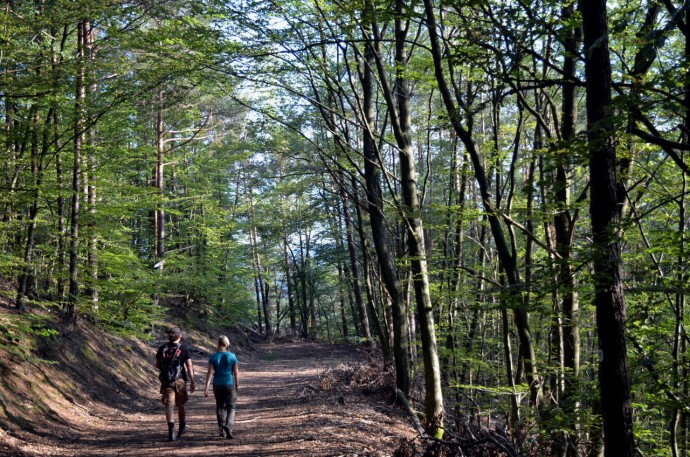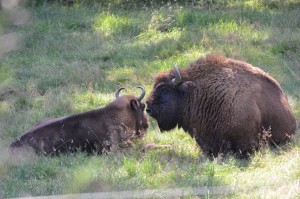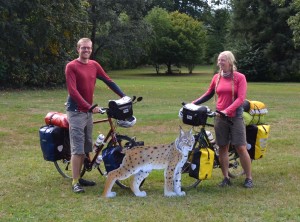Dave and Anna, two environmentalists from the United Kingdom, started their “Biking for Rewilding” tour in April 2015 after leaving their office jobs and taking off on an adventure with a purpose. The 4,000 km cycling tour led them through seven European countries, where they visited seven rewilding areas. The final two destinations were Wisent Welt and the Palatinate Forest Biosphere Reserve in Germany, members of the European Rewilding Network (ERN).

After visiting the European bison project in the Kraansvlak area on the Dutch coast, we headed off to Germany to visit two rewilding projects. We cycled more than 300 km of hilly forest tracks arriving in Bad Berleburg to visit Wisent Welt (‘Bison World’). We met with Coralie Herbst, who gave us a detailed and fascinating insight into the origins of Wisent Welt, another member of the European Rewilding Network. Wisent Welt runs this bison project on land privately owned by Prince Richard zu Sayn Wittgenstein Berleburg. It was the Prince’s idea to bring back the bison to Germany.
The first bison at Wisent Welt were kept in an enclosure and after several years of research on the effects they were having on the environment, the bison were released into the forest. The wild herd, now consisting of 17 animals, was released two years ago whilst 7 still remain in the enclosure. The wild herd is extremely elusive, and although we enjoyed looking for the animals, we never did find them. But our excursions were not for nothing – we saw wild boar, roe deer and red deer in the forest at dawn, which was a wonderful experience.

We had a fantastic time at Wisent Welt, learning about bison in the wild and working with the lovely people there. I’m also excited to mention that Dave and I got engaged during our stay at Wisent Welt, so it will always have a special place in our hearts.
After we waved goodbye to the bison and the bison team, it was time to pedal to the neighboring rewilding project. We cycled through forests, villages and vineyards to reach our final stop in the Biosphere Reserve Palatinate Forest “Biosphärenreservat Pfälzerwald“. The Biosphere Reserve is 36,000 ha in size and part of the Natura 2000 Network.
In a small village in Western Germany, between the Rhine and the French border, there are plans afoot to bring back the Eurasian lynx! To find out more, we arrived at the offices in Trippstadt to meet with Sylvia Idelberger, the project leader and her team. We were very well received and greeted with pastries, home pressed apple juice and an interview with the local press! After that, we met with the lynx ecologist Julian Sandrini, who offered us accommodation at his house during our visit. We basked in the kindness of our hosts and chatted about the lynx before starting with the work the next day.
The Eurasian lynx was eradicated across most of Western Europe by 1850, but populations managed to survive in Scandinavia, Eastern Europe and Asia. Unlike the wolf, which is re-colonising Europe of its own accord, the lynx usually does not leave its home range when there is no sign of a neighboring population. This means that the only way to get lynx back into an area where it previously occurred is to reintroduce it. The aim of the project is to restore the function of predation in the ecosystem and re-establish evolutionary processes by establishing a reproducing sub-population of the lynx in the Palatinate Forest.
This EU LIFE Project is led by a local organisation called Stiftung Natur und Umwelt Rheinland-Pfalz. The plan is to capture wild lynx from healthy populations in Switzerland and Slovakia, transport them to Germany and release them in the Palatinate Forest in spring 2016. Eventually 20 animals will be introduced. Only a few animals can be captured at each donor location each year, so the reintroduction will be staggered over five years. A population of 20 lynx is quite small and the potential for inbreeding is a concern, but hopefully the new population will mix with other established populations across the border in France and ensure a healthy gene pool.

Bringing back predators is a sensitive subject and these plans did not come about overnight. Extensive consultations took place with local people, along with the hunting and farming communities. After many years of discussion it is safe to say that stakeholder relations are now favorable. Michael Back, one of the rewilding organisation’s employees and a respected member of local community, works with his two dogs to find injured animals in the forest. Once the lynx is back, there is a chance he may be called upon to find an injured lynx, so he has been training his dogs to prepare for such a situation. They know how to smell out the animals and recognize their traces, such as hair and blood. They know what to do if they find an injured lynx, so that neither dog nor lynx is harmed during the encounter. Dogs can also help trace where the lynx was injured, so that the cause of injury could potentially be established.
During our visit, we spent time with ecologists and researchers. The lynx have not arrived yet, so this was a great time for researchers to collect baseline data to measure the impacts of the reintroduction when it happens. There are researchers monitoring populations of red deer and roe deer in the area, which is important because lynx primarily hunt roe deer – a female lynx can take around 77 roe deer in a year to feed herself and her young. Nevertheless, it is important to remember that the lynx have large home ranges, so the impact is spread over a big area.
The Palatinate forest looks like a great place to bring back the lynx and I am looking forward to follow the reintroduction process and seeing how the population establishes itself.
With our time in the Palatinate Forest drawing to its end, so does our 2015 Biking for Rewilding tour, and it is time to make our way back to London. We headed for the Eurostar in Brussels and waved goodbye to continental Europe for the winter. We plan to spend the cold, dark months in London working, volunteering and taking a few courses. Then we are going to welcome spring by getting married and excitedly planning our next venture. Until then, we would like to say thank you to Rewilding Europe for your support of and help with the organisation of our visits to European Rewilding Network projects, and to all of our wonderful hosts who have taken the time to talk to us, look after us, debate with us and provide us with food, shelter and friendship. You have all been fantastic!
You can find the latest from us on our website, including articles and recommended reading. To find out more about the European Rewilding Network, its members and how you can join click here.
